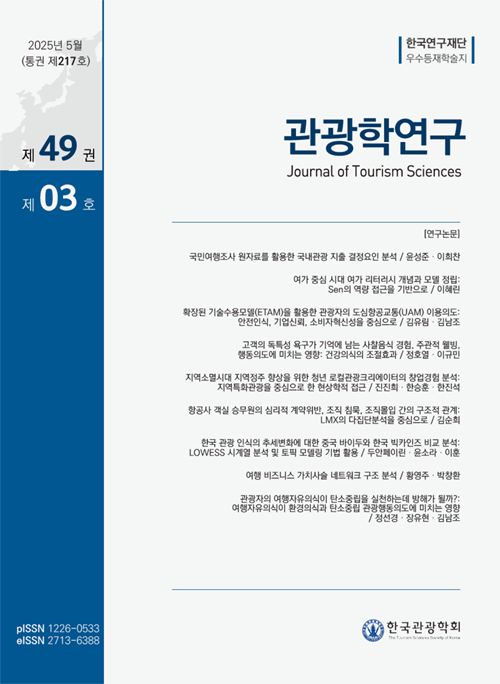이 연구는 내국인의 국내관광 지출의 결정요인을 살펴보고 세부 지출 항목별 영향력의 차이를 검증하여 국내관광시장 활성화 전략을 제시하는 것을 목적으로 한다. 문화체육관광부의 국민여행조사 원자료를 바탕으로 다수의 ‘0’ 및 절단된 값이 존재하는 데이터의 특성을 고려하여 Tobit 모형을 활용하여 분석하였다. 종속변수는 총 지출액, 식음료비, 교통비, 관광 활동비, 쇼핑비이며 독립변수는 4가지 범주(심리적 변수, 관광 관련 특성, 사회인구학적 특성, 경제적 제약)로 설정하였다. 분석 결과 첫째, 심리적 변수 중 전반적 만족도는 총 지출액, 식음료비 및 쇼핑비에, 혼잡 만족도의 경우 총 지출액, 식음료비, 관광 활동비, 쇼핑비에 유의한 정(+)의 영향력을 보였고 관광 정보 및 안내시설 만족도의 경우 식음료비, 관광 활동비에 정(+)의 영향을, 쇼핑비에는 부(-)의 영향력을 보였다. 둘째, 여행 관련 특성은 일반 동반자 포함 및 15세 미만 동반자 포함 시 총 지출액 및 식음료비, 교통비, 쇼핑비에 부정적인 영향을 미치나 관광 활동비는 증가시키는 것으로 나타났다. 셋째, 사회인구학적 특성에서는 여성보다는 남성이 관광 활동비를, 남성보다는 여성이 쇼핑비에 더 많은 지출을 하는 것으로 나타났다. 그리고 연령이 낮을수록 총 지출액, 교통비, 관광 활동비, 쇼핑비를 더 지출하는 경향이 나타났으며 교육수준이 높을수록 총 지출액, 식음료비, 교통비 지출액이 높은 것으로 나타났다. 넷째, 경제적 제약에서 소득 수준이 높을수록 총 지출액, 식음료비, 교통비, 관광활동비를 더 지출하며 관광지 물가 만족도는 모든 지출 항목에서 유의한 결과를 보였다. 다섯째, 관광자의 거주지역을 벗어나는 관광에서 총 지출액, 식음료비, 교통비, 쇼핑비를 더 많이 지출하는 것으로 나타났으며 관광 활동비는 거주지역 내의 관광 형태에서 더 많이 지출한다는 결과를 보였다. 이 연구는 지출 항목별 세부 만족도의 영향력을 살펴보고 근/원거리 관광 형태에 따른 지출액의 차이를 도출하였다는 점에서 학문적 기여도가 있다. 또한 시장참여효과와 소비량효과에 따른 차별화된 실무적, 정책적 전략을 제시하였다는데 의의가 있다.
This study examines the determinants of domestic tourism expenditure among Korean tourists and the varying influences of factors across expenditure categories. Using data from the Korea National Travel Survey conducted by the Ministry of Culture, Sports and Tourism, the Tobit model was employed to address the censored nature of the data, characterized by multiple zeros and truncated values. The dependent variables include total expenditure(TOTAL), food and beverage(FNB), transportation(TRANS), tourism activities(ACT), and shopping(SHP). Independent variables are categorized into four groups: psychological factors, trip-related characteristics, socio-demographics, and economic constraints. The results reveal that overall satisfaction significantly increases TOTAL, FNB, and SHP expenditures. Congestion satisfaction positively affects TOTAL, FNB, ACT, and SHP expenditures. Satisfaction with tourism information and facilities positively influences FNB and ACT expenditures but negatively impacts SHP. Traveling with general companions and children under 15 negatively affects TOTAL, FNB, TRANS, and SHP expenditures, while it positively influences ACT expenditures. Regarding socio-demographic factors, men tend to spend more on ACT, whereas women allocate more to SHP. Younger individuals exhibit higher spending on TOTAL, TRANS, ACT, and SHP, while individuals with higher education levels have greater expenditures on TOTAL, FNB, and TRANS. Higher income leads to increased spending across all categories except SHP, and price satisfaction significantly influences all expenditure categories. Additionally, expenditures on TOTAL, FNB, TRANS, and SHP are higher when traveling outside the tourists' residential areas, whereas spending on ACT is greater in local travel. This study contributes academically by examining the impact of detailed satisfaction levels across expenditure categories and identifying differences in spending patterns between short and long distance travel. Additionally, its significance lies in presenting differentiated practical and policy strategies based on market participation and consumption effects.
Ⅰ. 서 론
Ⅱ. 이론적 고찰
Ⅲ. 연구방법
Ⅳ. 분석결과
Ⅴ. 결론
References
(0)
(0)
